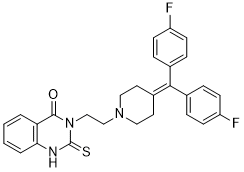| Cas No.: | 120166-69-0 |
| Chemical Name: | 3-[2-[4-[bis(4-fluorophenyl)methylidene]piperidin-1-yl]ethyl]-2-sulfanylidene-1H-quinazolin-4-one |
| Synonyms: | R59949;R 59949 |
| SMILES: | FC1C=CC(/C(/C2C=CC(F)=CC=2)=C2/CCN(CCN3C(=O)C4C(=CC=CC=4)NC3=S)CC/2)=CC=1 |
| Formula: | C28H25F2N3Os |
| M.Wt: | 489.585 |
| Purity: | >98% |
| Sotrage: | 2 years -20°C Powder, 2 weeks 4°C in DMSO, 6 months -80°C in DMSO |
| Description: | R59949 is a pan diacylglycerol kinase (DGK) inhibitor with an IC50 of 300 nM. R59949 strongly inhibits the activity of type I DGK α and γ and moderately attenuates the activity of type II DGK θ and κ. R59949 activates protein kinase C (PKC) by enhancing the levels of the endogenous ligand diacyl glycerol[1][2][3]. |
| In Vitro: | In the presence of R59949, vasopressin- as well as collagen-induced release reaction and aggregation was strongly increased, independently of the formation of arachidonate metabolites[1]. In THP‐1 monocytes, R59949 attenuates CCL2‐evoked Ca2+ signalling with a half‐maximal concentration of 8.6 μM[2]. R59949 inhibits inducible nitric oxide production through decreasing transplasmalemmal L-arginine uptake in vascular smooth muscle cells[4]. |
| References: | [1]. de Chaffoy de Courcelles D, et al. The role of endogenously formed diacylglycerol in the propagation and termination of platelet activation. A biochemical and functional analysis using the novel diacylglycerol kinase inhibitor, R 59 949. J Biol Chem. 1989;264(6):3274-3285. [2]. Day P, et al. Inhibitors of DAG metabolism suppress CCR2 signalling in human monocytes. Br J Pharmacol. 2019;176(15):2736-2749. [3]. Meinhardt G, et al. Effect of novel modulators of protein kinase C activity upon chemotherapy-induced differentiation and apoptosis in myeloid leukemic cells. Anticancer Drugs. 2002;13(7):725-733. [4]. Shimomura T, et al. R59949, a diacylglycerol kinase inhibitor, inhibits inducible nitric oxide production through decreasing transplasmalemmal L-arginine uptake in vascular smooth muscle cells. Naunyn Schmiedebergs Arch Pharmacol. 2017;390(2):207-214. |

 To enhance service speed and avoid tariff delays, we've opened a US warehouse. All US orders ship directly from our US facility.
To enhance service speed and avoid tariff delays, we've opened a US warehouse. All US orders ship directly from our US facility.




















